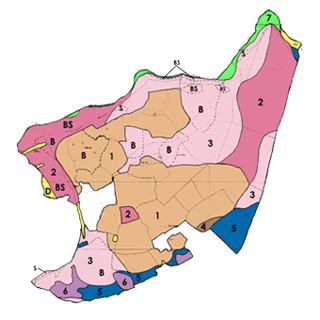
“We know more about the movement of celestial bodies than the soil underfoot” – LEONARDO DA VINCI
Bearing this in mind, we commissioned a comprehensive Soil Survey by the eminent expert Tim Harrod. The entire report can be downloaded in PDF format (1.2mb) by right clicking here and selecting “Save Target As…”
The farm has a widespread mantle of sandy silt loam soil material. In places surface accumulation of organic matter has formed humose sandy silt loam or peaty topsoils and some thicker peat
Although the altitudinal range of the farm is limited, most of the soils found across Bodmin Moor are present. Most extensive are the freely draining Moretonhampstead and Moor Gate soils. Moretonhampstead soils, occupying the longer enclosed land, including the Bronze Age field system, have only small amounts of organic matter in their topsoils. By contrast the other soils have black, humose or peaty surface horizons. At the southern end of the farm are a few hectares affected by groundwater. In places, where groundwater reaches the surface throughout the year, there is thick peat
The local soils are all inherently acid. On the agricultural land topsoils are moderately acid to neutral in reaction; under semi-natural vegetation surface pH is strongly or moderately acid
There is an association between the soils and landscape history. Moretonhampstead soils occupy the old enclosures, both those of Bronze Age and medieval origin. Boundaries to former moorland soils outside the enclosures are often sharp and follow the hedge banks. Additionally peaty topsoil development on the highest old downland seems to have benefited from protected landuse over many centuries. Was it that the enclosers astutely followed soil differences or has farming and moorland management since enclosure brought about much of the soil differences seen today?
The medieval system was mixed livestock and arable farming, cultivating strips for 2 or 3 years followed by longer intervals under grass. The, albeit limited, colluvial or lynchet development above the lower hedge banks suggest that cultivation may have taken place over long periods, since the slopes involved are rarely steeper than 3 or 4 degrees. It seems unlikely that on Moretonhampstead soils, with their limited inherent fertility, that this could have continued for long period without adding nutrients. Then, and for most of the period since, there would have been no question of importing these from far outside of the farm
So how was it done? Cutting of moorland vegetation, such as bracken, for bedding livestock, with subsequent spreading of the spent bedding and faeces on the land is one possible answer. This would amount to “mining” of nutrients from the moorland soils and subsoils. Collection of vegetation from the moor and its burning on the fields, in a modification of beat burning, is perhaps another means. Grazing stock on the moorland and bringing them into the enclosures each night, yet another. The latter, perhaps with the elaboration of housing stock on bracken bedding, may have been necessary, either to conform with the ancient laws of levancy and couchancy, or simply for protection against predation or theft
The bringing in of vegetation from the moorland may have helped sustain nutrients on the enclosed land, but at the cost of their loss from the moorland. This may have accelerated acidification and podzolisation there
Whatever the explanation, medieval farmers and their successors before the ready availability of fertilisers, appear to have found a sustainable farming system on soils that, although freely drained and easy working, have little inherent long-term fertility
